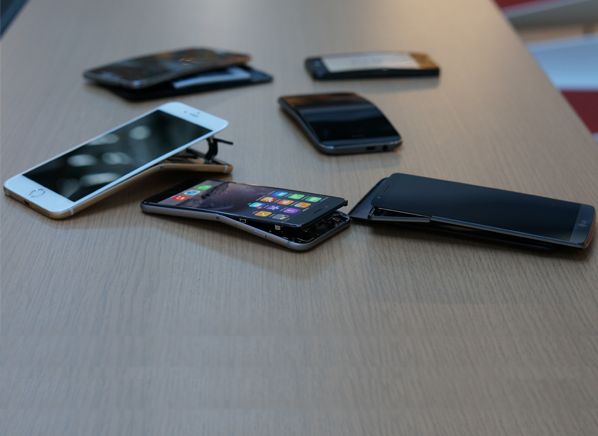By now anyone who follows technology – and many who don’t – has heard about #BendGate, the term coined after a video showed how easy it was to bend and distort the iPhone 6/6+. Honestly, I wasn’t surprised – they are incredibly thin and light with an elongated aspect ratio. But is #bendgate REAL? Consumer Reports took a scientific look!
The lab used a standard crush test instrument made by Instron (this is what computer labs like HP have used for decades, and it’s what all phone manufacturers use to check their devices), and engaged in a ‘three point bend’ test. This industry standard test has fixed points on either end (though, usually it is better than two non-attached wood blocks) with the force applied in at least one point in between. The Consumer Reports test used a teflon/delrin block at the center to distribute the force without applying a ‘point force’ that would distort results.
According to Consumer Reports:
All the phones we tested showed themselves to be pretty tough. The iPhone 6 Plus, the more robust of the new iPhones in our testing, started to deform when we reached 90 pounds of force, and came apart with 110 pounds of force. With those numbers, it slightly outperformed the HTC One (which is largely regarded as a sturdy, solid phone), as well as the smaller iPhone 6, yet underperformed some other smart phones.
Throughout most of our test, the LG G3 and Samsung Galaxy Note 3 bent, then recovered completely from each step up in force. But at 130 pounds, the case of the G3 fractured. At 150 pounds of force, the Note 3’s screen splintered and it stopped working.
The lousy HTC One M8 performance surprised me, and honestly I am not surprised that the iPhone 5 is close to the Samsung Galaxy Note 3. I have both the iPhone 5 and the Note 3 next to me as I write … and they are each ‘stop a bullet’ type beasts.
I was surprised that the iPhone 6 performed worse than the 6 Plus … but honestly that means that Apple did their job in the design, and the force was distributed over a wider region.
What do you think? Does this change any of your thoughts on the new iPhones? Either way, it makes for a fun watch!
Here is the Consumer Reports #BendGate video:


Nope. Much to my surprise Consumer Reports completely missed the story – and so did you.
BendGate refers to a specific issue that some iPhone 6 Plus owners are reporting, namely that this phablet has structural flaw around the volume buttons. Consumer Reports didn’t test for that, so their tests are irrelevant.
To give you an analogy , let’s say that a bunch of owners of a particular car model report that side impact collisions reveal that it has a poor structural design. CR jumps in, tests the model for front impact, and concludes that the user reports are bogus.
Do you see my point? CR didn’t use a test which recreated the same conditions, and so their test results are irrelevant.
Actually I partially see your point, but you are also partially wrong.
I am assuming you are not a science person, because otherwise you wouldn’t have said some of the things you did. I am not going to spend the time discussing force distributions, flaw populations and propagation … but if you look at the image at top and see how some phones broke at the center and others about 2/3 way up (i.e. near volume buttons) you can see how a non-central weakness will will present itself preferentially even when a central force is applied. This is what makes the test work.
In other words, you are *totally wrong* saying that “their tests are irrelevant”.
But … you are not wrong when you say they didn’t replicate the condition exactly. The guy who filmed himself applying bend & twist force ALSO didn’t replicate the conditions – thereby making his test even worse because it is unscientific and seeking to prove a point rather than to objectively study things. But that is a pretty typical way non-science people do things – and ‘confirmation bias’ will allow all kinds of things to get a pass.
HOWEVER, you are also incorrect saying it has a ‘structural flaw’. Flaws are ‘defects’, whereas what we are seeing is a ‘weak point’ – one that is there ‘by design choice’. If you look at any of the tear-downs, you will see that Apple used the body as the structural stability point – whereas most other phones have some other framing elements, such as the iPhone 5 or Galaxy Note 3. So as I have said I am not surprised that the iPhone 6 is weaker – but that is the price we pay for driving everything to be thinner and lighter with bigger screens. Physics … it is THE LAW! 🙂
Finally, your analogy doesn’t work … not at all. To correct it, it would be better to think that people were reporting bumper failures on a new car, based on hitting slightly right of center. The car company (or CR) tests with a normal force at center. Not exactly the same, but generally indicative. Someone on YouTube takes a crowbar and sledgehammer and bases at one end until it falls off and says ‘see, told you so!’